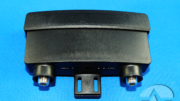As the year winds to a close, we’re looking back at the events that really shaped our product selection at SolidSignal.com. There were two big events this year in the world of over-the-air antennas and although broadcasting’s been around almost a century, to have these two things happen in one year is pretty earth-shattering.
The FCC shrinks the field…
The big story is the broadcast TV repack. This has been in the works for several years, so it wasn’t a surprise to see it rolling toward a conclusion this year. You see, we all want faster speeds on our cell phones and that means cellular data has to take up a bigger chunk of radio frequencies. Since only about one-quarter of the broadcast TV frequencies are used in any one market, that seemed to everyone to be a perfect place to pull some unused resources out and allocate them to something we all want.
The first step was trying to get broadcasters to sell back their licenses. That was basically a flop, as very few of them did. Cord-cutting gets stronger every year and station owners aren’t willing to give up on broadcast TV as easily as the FCC thought.
Even so, they moved forward with a plan to eliminate broadcast channels 37-51 (channels 52-83 were already removed in earlier plans) and give those broadcast frequencies in the 600-700MHz range to cell companies. New licenses were issued and sold, and existing TV broadcasters were told that they would be moving “down the spectrum” to lower channel numbers. The changes will take place in stages over the next year or so, and all it should take is a quick channel rescan on your TV and you’ll be set in most cases. In a few cases a channel you want may be moving to a VHF frequency and you may need a different kind of antenna.
…and then they added more broadcasts.
The big surprise this year was when the FCC decided to allow ATSC 3.0 simulcasts. ATSC 3.0 is supposedly the next generation of TV broadcasting that will allow 4K and other advanced features over a broadcast signal. While interest from the general public has been pretty weak, a few very powerful companies like Sinclair Broadcast Group really want this to happen. In the past, the FCC looked at a change like this as a gradual process where test broadcasts would be allowed and eventually there would be a transition like the one we saw in 2009. This time, the FCC said it was perfectly ok to broadcast an ATSC 3.0 signal — which today’s TV’s can’t receive — as long as you were broadcasting the same thing as your regular signal.
There are a few problems with this. First of all is how it flies in the face of 80 years of broadcasting law. The broadcast TV and radio bands have always been set up so that every receiving device (radio or TV) could receive every signal. Looking back at the last transition, Congress voted to give away $100 to every household in America so that they could buy equipment to make their TVs compatible. Not this time. This time it’s just up to you to buy a new TV. Tough luck for you if you just bought one.
Second of all since the FCC is giving away about half the broadcast spectrum to cellular, some very large markets like New York and Los Angeles don’t have enough channels for every station to broadcast on two of them. This threatens to stop ATSC 3.0 adoption, if 60 million people in urban areas can’t participate.
It’s very hard to know if this move to ATSC 3.0 is going to go anywhere. Without any direction or support from Congress, it will be up to the free market to start driving 4K content and advanced broadcasts. As of now, there is no 4K content out there available for broadcasting and there’s very little demand for it. In the short term this may simply strangle sales of existing TVs until new ones come out with upgraded tuners. Companies like Sinclair who hope that this new standard will open up advertising opportunities may find out that people’s commitment to watching commercials just isn’t as strong as they think.
No matter what…
I can say that the world of antennas finished strong in 2017 and that 2018 looks just as strong. If you buy a UHF/VHF antenna you’ll find that you have everything you need no matter what broadcast standard eventually wins, and remember, the best selection of antennas is at SolidSignal.com!





